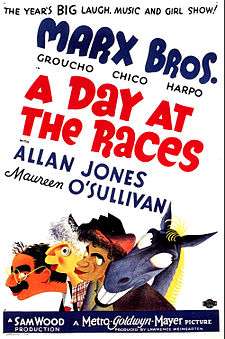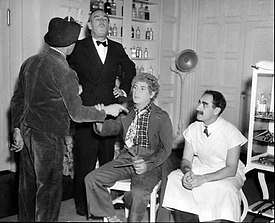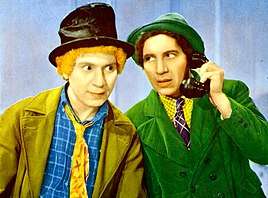A Day at the Races (film)
A Day at the Races (1937) is the seventh film starring the Marx Brothers, with Allan Jones, Maureen O'Sullivan and Margaret Dumont. Like their previous Metro-Goldwyn-Mayer feature A Night at the Opera, this film was a major hit.[1]
| A Day at the Races | |
|---|---|
 theatrical release poster | |
| Directed by | Sam Wood |
| Produced by | Sam Wood Irving Thalberg (uncredited) Lawrence Weingarten (uncredited) |
| Written by | Robert Pirosh George Seaton George Oppenheimer |
| Screenplay by | Al Boasberg (uncredited) Leon Gordon (uncredited) George S. Kaufman Carey Wilson |
| Starring | Groucho Marx Harpo Marx Chico Marx Allan Jones Maureen O'Sullivan Margaret Dumont |
| Music by | Walter Jurmann Bronislau Kaper Franz Waxman |
| Cinematography | Joseph Ruttenberg |
| Edited by | Frank E. Hull |
| Distributed by | Metro-Goldwyn-Mayer |
Release date |
|
Running time | 109 minutes |
| Country | United States |
| Language | English |
Plot
The Standish Sanitarium, owned by Judy Standish (Maureen O'Sullivan), has fallen on hard times. Banker J.D. Morgan (Douglass Dumbrille), who owns a nearby racetrack and nightclub, holds the mortgage to the sanitarium and is attempting to gain control of it in order to convert the building into a casino. Judy's faithful employee Tony (Chico Marx), suggests asking financial help from the wealthy hypochondriacal patient Mrs. Emily Upjohn (Margaret Dumont). After she has been given a clean bill of health by the doctors at the Sanitarium, Mrs. Upjohn threatens to leave for treatment by Dr. Hugo Z. Hackenbush (Groucho Marx), who - and unknown to Mrs. Upjohn - is actually a horse doctor. Tony overhears Mrs. Upjohn's praise of Hackenbush and immediately tells her that Dr. Hackenbush has been hired to run the sanitarium. Mrs. Upjohn is elated and informs Judy with Dr. Hackenbush in charge she will consider helping her financially. Tony then wires Dr. Hackenbush in Florida to come and care for Mrs. Upjohn at the sanitarium. Soon, Dr. Hackenbush arrives and instantly begins insulting the sanitarium's crooked business manager Mr. Whitmore (Leonard Ceeley). Whitmore, who is Morgan's right-hand man, is immediately suspicious of Hackenbush's medical background.
Meanwhile, Judy's fiancé, Gil Stewart (Allan Jones), who works singing in Morgan's nightclub, has just spent his life's savings on a racehorse named Hi-Hat. His hope is that the horse, which he purchased from Morgan, will win a big race and the prize money will allow Judy to save the sanitarium. Hi-Hat is so afraid of Morgan, that the horse rears in terror whenever he sees Morgan or hears his voice. Unfortunately, Gil now has no money to pay for Hi-Hat's feed, and he, Tony and Stuffy (Harpo Marx), Hi-Hat's jockey, have to resort to trickery to fend off the Sheriff (Robert Middlemass) who has come to the racetrack to collect money for the feed bill. Tony raises some money by scamming Hackenbush in the "Tutsi Fruitsy Ice Cream" scene, in which Tony gives Hackenbush a tip on a horse, but all in code, so that Hackenbush has to buy book after book from Tony to decipher the code.
At the sanitarium, the suspicious Whitmore attempts to telephone the Florida Medical Board for information on Hackenbush's background. Hackenbush intercepts the call and by assuming a phony southern accent, feigning a hurricane with an electric fan and repeatedly calling Whitmore to the dictagraph, Hackenbush manages to enrage him to the point that Whitmore slams down the phone in frustration and gives up. Later, Whitmore attempts to get Hackenbush fired by having Mrs. Upjohn catch him in a compromising situation with a blonde floozie (Esther Muir). Hackenbush is rescued by Stuffy and Tony who overhear the plot, then pose as house detectives and then as paperhangers. They make a complete shambles of Hackenbush's suite with layers of wallpaper and buckets of paste; Mrs. Upjohn and Whitmore arrive, but the blonde harlot is nowhere to be seen, having been stuffed under the cushions of the sofa. The following day, just as Mrs. Upjohn is about to sign an agreement to help Judy, Whitmore brings in an eminent Viennese physician, Dr. Leopold X. Steinberg (Sig Ruman), whom he hopes will examine Mrs. Upjohn and discredit Hackenbush. After Mrs. Upjohn agrees to the examination, Hackenbush wants to flee for fear of being exposed as a fraud; Gil, Tony and Stuffy remind him that Judy still needs his help and persuade him to stay.
After making a shambles of Mrs Upjohn's examination, Hackenbush, Tony, Stuffy and Gil hide out in Hi-Hat's stable, where Judy soon joins them. Whitmore finally exposes Hackenbush as a horse doctor with a letter he received from the Florida Medical Board and Morgan is about to have them arrested when Hi-Hat hears Morgan's voice and bolts, jumping several obstacles in the way. Gil realizes that Hi-Hat is a jumper, and the following day enters him in the steeplechase race. Morgan, who witnessed Hi-Hat's jumping ability, tries to prevent him from being entered in the race. After intentionally delaying the race several times and getting past Morgan and the Sheriff, the boys, Gil and Judy manage to get Hi-hat onto the track and the race finally begins. Knowing that Hi-Hat is afraid of Morgan, everyone works to make Hi-Hat aware of his presence before reaching the fence.[2][3][4] On the last lap, Hi-Hat and Morgan's horse wipe out; when they reach the finish line, it appears that Morgan's horse has won; Stuffy realizes that the mud-covered horses were switched after the accident, and Morgan's jockey was riding Hi-Hat in the finish, thus making Hi-Hat the winner.
Cast
|
Cast notes
- In My Life with Groucho: A Son's Eye View, Arthur Marx relates that in his latter years Groucho increasingly referred to himself by the name Hackenbush.[6]
Production

The film went through numerous outlines, treatments, drafts, revisions and a total of eighteen different scripts before arriving at its final version. A major portion of the final screenplay was written by Al Boasberg, but due to a bitter disagreement with MGM, he chose not to be given any credit for his work. As they had with A Night At The Opera, the Brothers honed the comic material during a pre-production vaudeville tour.
Groucho's character was originally named "Quackenbush" but was changed to "Hackenbush" over threats of lawsuits by several real doctors named Quackenbush.
During production, Irving Thalberg, who had brought the Marx Brothers to MGM, died suddenly in September, 1936 of pneumonia at the age of 37. Thalberg's death left the Marxes without a champion at MGM, and the studio never gave the same level of care and attention to the team they had received under Thalberg. As a result, the Marx Brothers three later MGM films are generally considered to be vastly inferior to their first two.[7]
The original release of A Day at the Races presented the water carnival sequence in light brown sepia and the ballet scene with a blue tint.[8]
The film used Santa Anita Park as a filming location for some of the racetrack scenes.[9]
Music
The songs in the film, by Bronislaw Kaper, Walter Jurmann, and Gus Kahn, are "On Blue Venetian Waters", "Tomorrow Is Another Day", and "All God's Chillun Got Rhythm" (which features Ivie Anderson from Duke Ellington's orchestra). Two other songs were slated for the film, but ultimately cut . One, "Dr. Hackenbush", sung by Groucho about "what a great doctor he is" ("No matter what I treat them for they die from something else") was performed on the pre-filming tour, but was apparently never shot; the other, "A Message From The Man In The Moon", sung by Allan Jones, was shot, but was cut at the last minute because the film was too long. The melody is heard during the opening titles, some incidental music during the Water Carnival scene, and is "reprised" by Groucho during the final scene. The DVD release of the film includes a recently rediscovered audio recording of the song, performed by Allan Jones.
The film also features a lindy hop dance sequence set to the tune of "All God's Chillun Got Rhythm", and featuring Whitey's Lindy Hoppers, including Willamae Ricker, Snookie Beasley, Ella Gibson, George Greenidge, Dot Miller, Johnny Innis, Norma Miller and Leon James.[10]
"Cosi-Cosa", a song sung by Allan Jones in A Night at the Opera, makes an instrumental cameo at the opening of the climactic racetrack scene.
Musical numbers
- "On Blue Venetian Waters"
- "Tomorrow Is Another Day"
- "All God's Chillun Got Rhythm"
- "Nobody Knows the Trouble I've Seen"
- "A Message from the Man in the Moon"
Reception
Contemporary reviews from critics continued to be positive for the Marx Brothers through their seventh film. John T. McManus of The New York Times called it "comparatively bad Marx," although still deserving of "a much better than passing grade" because "any Marx brothers motion picture is an improvement upon almost any other sustained screen slapstick."[11] Variety declared, "Surefire film fun and up to the usual parity of the madcap Marxes."[12] Harrison's Reports wrote, "Very good! The Marx Brothers are at their best and funniest here."[13] John Mosher of The New Yorker was also positive, writing that "Groucho, Harpo, and Chico are in full blast again," and the film "reaches a fever pitch even beyond earlier records."[14] The Chicago Tribune called it a "ridiculous farce, plummed with unique gags, laugh provoking situations, fast action ... The finale sends audiences away grinning and happy."[15]
The film is recognized by American Film Institute in these lists:
- 2000: AFI's 100 Years...100 Laughs – #59[16]
- 2005: AFI's 100 Years...100 Movie Quotes:
- Flo Marlowe: "Oh, hold me closer! Closer! Closer!"
- Dr. Hugo Z. Hackenbush: "If I hold you any closer, I'll be in back of you."
- - Nominated[17]
Awards
The dance sequence for "All God's Chillun Got Rhythm" was nominated for the short-lived Academy Award for Best Dance Direction, only given from 1935 to 1937.[18]
References
- Giddins, Gary (June 18, 2000). "There Ain't No Sanity Claus". The New York Times. Retrieved March 3, 2010.
- Tinee, Mae (July 3, 1937). "Marx Brothers Go Fast Pace in 'Day at Races'". Chicago Daily Tribune. p. 9. Retrieved March 3, 2010.
- Schallert, Edwin (June 17, 1937). "Marx Brothers Run Riot In "A Day At The Races"". Los Angeles Times. p. A15. Retrieved March 3, 2010.
- "Full synopsis" at TCM.com
- Bill Crow From Birdland to Broadway:Scenes from a Jazz Life, New York: Oxford University Press, 1992 [1993], p.24
- Marx, Arthur (June 1991). My Life with Groucho: A Son's Eye View. Robson Book Ltd. ISBN 978-0-86051-494-7.
- Thames, Stephanie. "The Big Store" on TCM.com
- "A Day at the Races". Turner Classic Movies. Retrieved August 27, 2016.
- "A Day At The Races – 1937". movie-locations.com. Archived from the original on 7 April 2019. Retrieved 7 April 2019.
- Manning, Frankie and Millman, Cynthia. Frankie Manning: Ambassador of Lindy Hop Philadelphia: Temple University Press, 2007
- The New York Times Film Reviews, Volume 2: 1932-1938. The New York Times & Arno Press. 1970. p. 1402.
- "Film Reviews". Variety. New York: Variety, Inc.: 12 June 23, 1937.
- "A Day at the Races". Harrison's Reports. New York: Harrison's Reports, Inc.: 103 June 26, 1937.
- Mosher, John (June 19, 1937). "The Current Cinema". The New Yorker. New York: F-R Publishing Corp.: 79.
- "Marx Brothers Go Fast Pace in 'Day at the Races'". Chicago Daily Tribune. Chicago: Chicago Daily Tribune: 9. July 3, 1937.
- "AFI's 100 Years...100 Laughs" (PDF). American Film Institute. Retrieved 2016-08-08.
- "AFI's 100 Years...100 Movie Quotes Nominees" (PDF). Retrieved 2016-08-08.
- A Day at the Races - Awards at IMDb
Further reading
- Buxbaum, Elisabeth: Veronika, der Lenz ist da. Walter Jurmann – Ein Musiker zwischen den Welten und Zeiten. Mit einem Werkverzeichnis von Alexander Sieghardt. Edition Steinbauer, Wien 2006, ISBN 3-902494-18-2
- Green, Stanley (1999) Hollywood Musicals Year by Year (2nd ed.), pub. Hal Leonard Corporation ISBN 0-634-00765-3 page 70
External links
| Wikiquote has quotations related to: A Day at the Races (film) |
| Wikimedia Commons has media related to A Day at the Races. |
